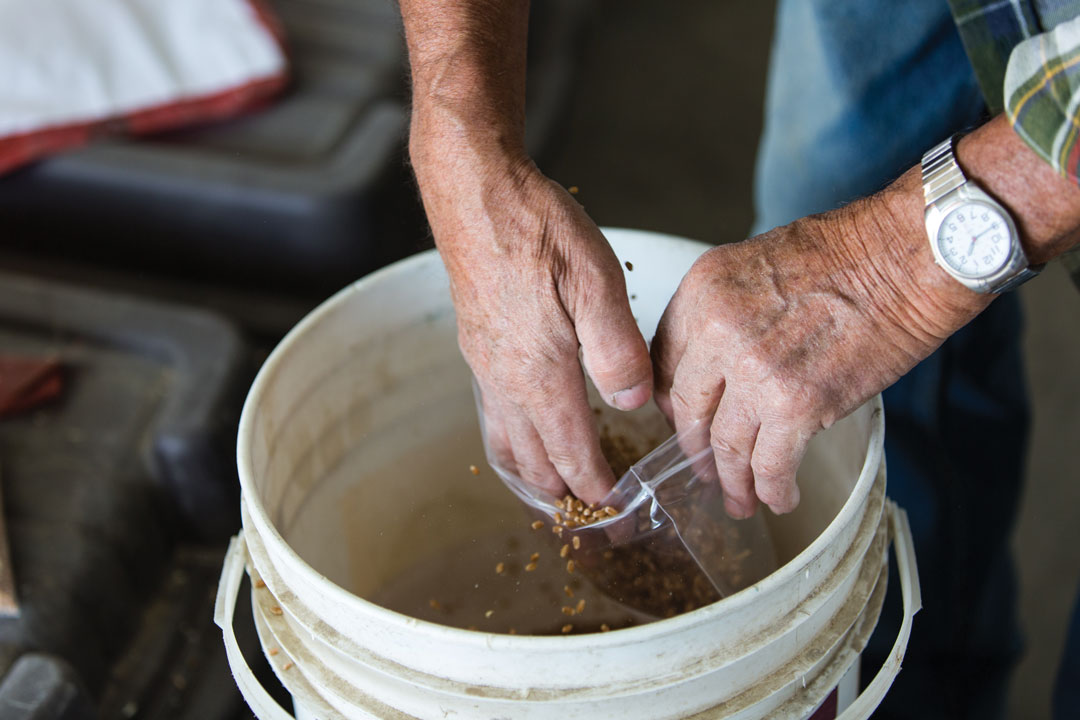HEEDING THE SEED IMPERATIVE
CANADA AT CROSSROADS IN CEREAL BREEDING, NEW INVESTMENT HANGS IN THE BALANCE
BY TREVOR BACQUE
Canadian farmers live in a UPOV91 compliant world. But what does this really mean? Well, depending whom you ask, it may not mean anything. Yet.
It took many years for Canada to become aligned under UPOV 91, the International Union for the Protection of New Varieties of Plants. The international framework allows nations to build an environment for investment and innovation in the seed business. It encompasses all types of seeds, including ornamentals, fruits, vegetables and grains.
Canada amended its Plant Breeders’ Rights Act to comply with UPOV 91 in February of 2015 and ratified it four months later. By taking these steps, it meant Canada could unlock a critical access point to put exemplary varieties into the hands of farmers while simultaneously increasing investment from seed companies. Currently, Canada has a mechanism in place to collect royalties on the sales of certified seed, however it does not provide a suitable return on investment since there is roughly about 20 per cent participation in certified seed use in cereals. Regarding farm-saved seed, there is no legislated trailing royalty. As the conversation continues, questions have arisen on how to increase private investment in order to morph that into the production of varieties farmers would be willing to pay for. Many industry players have been working to make tangible recommendations to government that are amenable to all, especially farmers.
Tom Steve is GM of the Alberta Wheat Commission. He and Erin Armstrong, CANTERRA SEEDS director of industry and regulatory affairs, co-chair the Value Creation Working Group (VCWG), a sub-committee within the federal government’s Grains Round Table (GRT). The VCWG was struck in spring of 2016 with a mandate to inform the federal government in November 2017 as to the potential for a new royalty system for cereals such as wheat and barley. Stakeholder consultations were held in Red Deer, Saskatoon and Ottawa in late March and early April of 2016 with the only result being mixed feelings.
“We got a lot of interesting feedback from those meetings, but certainly no consensus on a path forward,” said Steve. “In fact, part of what we heard from some of the groups was, ‘Why are we having this conversation at all? Is there a problem in cereal variety development?’ Other groups were saying, ‘We absolutely need a new model, there’s no return on investment for private or public breeders.’”
Following the meetings, a report was written that included a series of four options: continue as is, try to increase government funding levels to ensure that breeding programs are well funded, increase check-offs and funnel more money into breeding or, finally, determine a new method to create a more robust seed sector.
The report went out to seed companies, farmer-run commissions and individuals at the GRT with only more non-consensus produced by the summer of 2017. The VCWG was at a loss.
“We looked at those findings … and said, ‘What do we do now?’” explained Steve. The answer? Hold another meeting, of course. Two days in Winnipeg would be just what the doctor ordered. Based on the summer feedback, Steve and the group presented two broad models. The first was a farmer-enabled endpoint royalty (EPR) that essentially has royalties flow back to breeding institutes based on market share. The second was a contract-based system to allow farmers and the seed developers, or retailers, to have an agreement in place that would limit the use of farmsaved seed to potentially one or two years. Later, a trailing royalty could be imposed, with the idea that it would push farmers to purchase new certified seed, which is currently hovering around 20 to 25 per cent of Canadian wheat seed.
In both cases, scenarios could be concocted where private investment occurs, and new, high-performing varieties are made available to Prairie farmers. “Those two were put out as options, not endorsed by any sort of consensus among any working groups and reported back to the GRT,” said Steve. “Coming back to the round table, it was decided in a series of action items, to ask [the government] to do further analysis on those two models, including the economic viability of them.” However, Steve is a student of history and had read reports like this before.
“This topic has been debated a number of times in the past,” he said. “In the end, the government has not moved forward. Do they have enough to move forward this time? You’re going to be criticized if you do nothing and criticized if you do something. It’s a topic that can be somewhat divisive, so, unless there’s somebody willing to make a tough decision and to move the dial on it….”
One of the people who may affect such a decision is Anthony Parker, the commissioner of the Plant Breeders’ Rights Office at the Canadian Food Inspection Agency (CFIA). “It doesn’t surprise me that it’s difficult to come to consensus on the right model, and I think that’s OK,” said Parker from his Ottawa HQ. “Every country goes through this and you can’t take a model from one country and superimpose it. No two countries look exactly alike. Agriculture Canada has already gone through the GRT. It’s remarkable when parties can come together with different perspectives and be very altruistic about solutions. Maybe it makes them uncomfortable, or difficult given their history, but there seems to be a willingness to find a path forward.”
Parker notes that just by having the UPOV 91 legislation ratified, Canada has already seen a massive shift in plant breeding interest and investment. “Wheat, barley, oats, soybeans, canola and pulses and other crops; we receive on average, 93 [total] applications per year,” he said. “That number jumped to an average of 123 since UPOV 91, a 32 per cent increase.” Potato genetics have jumped from an average of 26 applications annually to 40, a cumulative effect that Parker describes as substantial.
The increase in varietal applications to the CFIA will ultimately create greater choice for farmers and has brought about renewed interest from businesses looking to be the ones to create said varieties. Having the door remaining ajar is critical for private speculation, Parker noted, adding that companies like Bayer and Limagrain had struck
Canada off their list until an environment was created where they could see value in doing business with Canucks. “Now, Canada has become a more attractive place to invest. We have a modern framework and a safe environment for intellectual property,” he said.
The monumental shift away from purchasing one year of seed and getting three to five for free may be ending, and Parker can see why. “Farm-saved seed is a wonderful thing—that farmers have the ability to save and reuse that innovation.
But, the fundamental question is, ‘If they are benefiting year after year because of that innovation, should they contribute back to the environment to spur on more innovation?’”
Other jurisdictions decided to answer that question many years ago. Australia, the United Kingdom, Argentina, Uruguay and many others have created systems unique to their countries allowing farmers and seed developers to thrive.
Glyn Chancey, executive director of the Canadian Seed Growers Association (CSGA), is buoyed by this seedy ballyhoo as it could spell big gains for Canada in the global marketplace.
“I’m more cautiously optimistic than I’ve ever been about the potential to actually achieve something because of the alignment of views that something needs to be done,” said Chancey. He has spent his entire working career with the federal government on plant programs and international trade, including major time spent on WTO and NAFTA negotiations before joining the CSGA two-and-a-half years ago.
His group, along with four other seed organizations and CropLife Canada, form a brain trust that recently released its Seed Synergy Collaboration Project “green paper,” a 23-page discourse on the state of Canada’s seed industry. Its signatories represent the majority of Canada’s seed industry. While they may not be willing to espouse how best to achieve a solution in Canada’s seed market, the six companies are in lockstep that the model must somehow be altered to fuel investment and innovation in Canada’s seed sector.
The government signalled the CFIA to undertake a modernization of its seed program and, laterally, value creation came up, explained Chancey. To that end, his group and others have responded by pushing for solutions by 2019, the year the government hopes to make amendments to the Plant Breeders’ Rights Regulations, which means work must be done immediately to meet hard deadlines.
The paper identifies six broad areas that need overhaul and attention: research and development, market entry and commercialization, production and processing, sales and distribution, seed sector governance and co-ordination as well as value creation. The group is openly critical of today’s regulatory approval process for new varieties, labelling it as “unpredictable” and “difficult for smaller businesses to navigate.” The paper also details plans for a modernized pedigreed seed system, which could, if taken to its logical conclusion, be pro-EPR, or another type of value creation to drive economic growth. Throughout the paper, it’s clear that there is a real level of frustration with the current system. What’s needed is an “industry-led, government-run” model, according to Chancey.
“We have a system in Canada that is a partnership between government and industry that has a lot of moving parts,” he said. “It’s a very intricate and somewhat messy system that does not allow easily for alignment of efforts. We’re not saying government needs to go out and industry come in, but we’re saying we need government in certain areas, and we need to take collective control of how the mechanics of this system operate.”
He points to France and the Netherlands as models of success, the latter country being widely viewed as the No. 1 destination on Earth for plant innovation. “Both those countries have industry-financed, industry-run systems with a lot of government oversight. They’ve managed to organize it so the business dynamics aren’t impeded by the slower moving government mechanisms.”
As the giant wheel of government turns, change will come. The aim is for Agriculture and Agri-Food Canada and the CFIA to conduct joint pre-consultations. The results of these outreach activities will inform the direction government takes on a specific value creation model, as part of any future Plant Breeders’ Rights regulatory amendments. Two review rounds will then follow, the first round being the true opportunity for tangible feedback. Following typical procedure, the second would then serve as an FYI to the public, with only minor revisions typically accepted. Investment capital goes where there are clear paths of return, which is why Canada must act with aplomb and efficiency in getting this right the first time, according to Chancey.
“The government has some very ambitious goals for agriculture,” he said, referencing the Liberals’ targeting a raise in current agriculture and agri-food exports totalling $24.6 billion to $75 billion by 2025. “I can’t think of any more effective way to raise the levels of productivity than raise the levels of plant breeding. Higher yields, better disease resistance, better quality. Those are things that can have a dramatic impact on farmers and also on the agricultural economy. The only way you get that is through investment. It is crucial that we keep trying.”
Parker is also keeping a sharp eye on worldwide competition and innovation. While he doesn’t believe Canada is behind the eightball yet, Parker will admit that the country has but one option left: evolve. “We have no choice but to compete on innovation intermutually. We have up and comers in the world where land costs are less, seasons are longer and access to tidewater is easier. If we can’t innovate and keep that advantage, what’s our future going to be?”







Comments